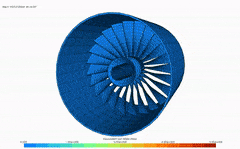Finite element analysis (FEA) is a computerized method for predicting how a product reacts to real-world forces, vibration, heat, fluid flow, and other physical effects. Finite element analysis shows whether a product will break, wear out, or work the way it was designed.
FEA enables you to predict potential design issues and therefore minimize risk to your product, profits, and your business. With FEA you can test the impact of varying conditions (stress, vibration, buckling, fatigue, creep, heat, etc.) on your design.
COURSE OBJECTIVES
Understand the capabilities of FEM and its importance in Engineering.
To introduce the concepts of Mathematical Modeling of Engineering Problems.
COURSE OUTCOMES
|
CO1:Understand the Fundamental Theory of Finite Element Method. |
|
CO2: Select and interpret Finite Element analysis results for design and evaluation purposes. |
|
CO3:Solve plain elasticity problem using energy approach |
|
CO4:Solve one dimensional heat transfer problems and two dimensional scalar variable problem using ANSYS. |
|
CO5:Develop a basic understanding of the limitations of the Finite Element method and understand the possible error sources in its use. |
|
CO6:Examine the longitudinal vibration, transverse vibration of beams, Mesh Generation and Errors in the finite element method. |
UNIT 1 1D FINITE ELEMENT METHOD 9 Hrs.
Historical Background -Basic concept of FEM- steps involved in FEA - Variational Formulation of Boundary value problem - Rayleigh Ritz Method - Weighted Residual methods-Finite Element Modeling - Element Equations - Shape functions -Bar, Beam Elements - stepped bar, tapered bar-simple problems
UNIT 2 2D FINITE ELEMENT METHOD 10 Hrs.
Basic Boundary Value Problems in 2 Dimensions - Triangular, quadrilateral, higher order elements - Poisson and Laplace Equations - Weak Formulation - Elements Matrices and Vectors -.Natural Co-ordinate System - Lagrangian Interpolation Polynomials - Iso-parametric Elements - Formulation -Numerical Integration -2D Triangular elements - rectangular elements - Illustrative Examples.
UNIT 3 SOLUTION TO PLANE ELASTICITY PROBLEMS 8 Hrs.
Introduction to Theory of Elasticity - Plane Stress - Plane Strain and Axisymmetric Formulation - Principle of virtual work - Element matrices using energy approach.
UNIT 4 APPLICATIONS IN HEAT TRANSFER & FLUID MECHANICS 9 Hrs.
One dimensional heat transfer element - application to one-dimensional heat transfer problems- scalar variable problems in 2-Dimensions - Applications to heat transfer in 2- Dimension - Application to problems in fluid mechanics in 2-D.
UNIT 5 SPECIAL TOPICS 9 Hrs.
Vibrational problems - equations of motion based on weak form -longitudinal vibration of bars - transverse vibration of beams Mesh Generation-Errors in the finite element method - various measures of errors- accuracy of the solution- Eigen value Problems - h & p elements- Applications of FEM software to solve simple problems, types of solver - a brief.
TEXT / REFERENCE BOOKS
1. J.N Reddy. “An Introduction to the Finite Element Method” , Mc Graw Hill, International Edition, 1993.
2. Seshu, P, “Text Book of Finite Element Analysis”, Prentice-Hall of India Pvt. Ltd., New Delhi,2007.
3. Segerlind L.J,“Applied Finite Element Analysis”, John Wiley, 1984.
4. Rao. S.S, “Finite Element Method in Engineering” , Pergamon Press, 1989.
5. Chandrupatla & Belagundu , “Finite Elements in Engineering”, Prentice Hall of India Private Ltd., 1997.
6. Cook, Robert Davis et al, “Concepts and Applications of Finite Element Analysis” , Wiley, John & Sons,1999.
7. George R Buchanan, “Schaum’s Outline of Finite Element Analysis”, McGraw Hill Company, 1994.
8. Taylor.C and Hughes.J.B. “Finite Element Programming of the Navier Stoke equation” Pineridge Press Limited, UK 1981

- ஆசிரியர்: Madhan Kumar G
